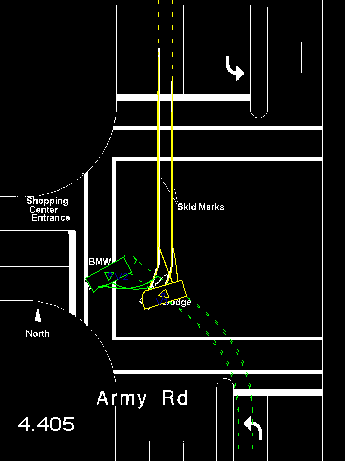
The Traffic Accident Reconstruction Origin -Approacn Angles Solution-


The Traffic Accident Reconstruction Origin -Approacn Angles Solution-
|

|
This is a solution to the "too fast" Approach Angles problem. It is by no means a complete reconstruction. Rather, it is a preliminary examination of the data with an eye toward finding answer to the question posed: Was the Lancer going "too fast?"
The reconstruction program I used was m-smac (McHenry Software's version of SMAC, however any version of SMAC would have given similar answers for this problem).
The specs for dimensions and weights for the vehicles were obtained
from the NHTSA Vehicle spec database and the Transport Canada SPECS database.
The BMW was approximated at 3200 lbs, the Lancer approximated at 2850 lbs
(both assuming an additional 200 lbs for driver and miscellaneous items).

I used the bitmap image of the accident site which was posted on TARO as a basis for the 'facts' of the case. A visual adjustment of the SMAC graphics was used to determine the approximate scale factor. I then assumed the BMW was traveling at approximately 15 mph at the collision. This speed is based on an eyeball estimate for the distance it traveled after impact. Then I "drove" the BMW through the turn with SMAC to arrive at the approximate POI at this speed. The path I chose was guided with the knowledge that the right side of the BMW was at the location where the Lancer's skid marks changed direction when it was struck. Once I got a good path, I then ran SMAC for the two vehicle collision. From a few iterations of the collision speeds I found that the Lancer required approx. 25 mph at the Point of Impact (POI) to knock the BMW out of it's way and slide to its observed point of rest.
Next, from the known point of collision, I backed the Lancer up to leave the observed 62.5' skidmarks. This required approx. 45 mph prior to brake application (probably somewhat more assuming 10% or more energy loss which occurs prior to leaving skidmarks).
The beginning of the animation (T=0.0 seconds) the Lancer starts at 44 MPH approximately 193' north of the intersection. This is before the driver of the Lancer has perceived a problem.
At approximately T=2.0 seconds the brakes were locked on the Lancer about 63' prior to intersection. If we assume a conservative estimate of approx. 1 sec Perception/Reaction (P/R) time, the start of P/R would have been when the Lancer was approx. 128' from the intersection
The Impact occurred at T=3.18 sec.
Impact Speeds:
Impact Speed changes:
The match is not 'perfect' but the speeds required are in the ballpark and support the fact that the Lancer was not much in excess of 45 MPH. Perhaps given the time required for the BMW to enter and turn through the three lanes of oncoming traffic at the intersection the BMW probably should have included a second 'look north'.
I captured the frames from my SMAC graphics program (with the bitmap underlay) and assembled them with Autodesk Animator Pro into an FLC movie. I used 0.10 sec increments between frames to reduce size of file. I also reversed the colors to save more file space. There are two animations here: an overall and a closeup.
The entire project was accomplished in about an hour. Download toofast.zip (approx 56K) containing a 227K FLC file.
If your don't have a FLC player you can download one from my demo page at the mchenrysoftware.com/demos
Brian G. McHenry and Raymond R. McHenry have worked together for the past 19 years with the past 17 years as McHenry Consultants, Inc.. Ray McHenry was the principle investigator on the Cal 2D occupant simulator, HVOSM, SMAC and CRASH while at Calspan in the 1960's and 1970's. Ray and Brian have continued research and development of these computer programs for the past 19 years. With the advent of the Pentium computer in 1994, all their computer research and processing has been moved from mainframe and mini-computers to Pentium PC computers. A separate venture, McHenry Software, includes development of PC versions of SMAC, CRASH, HVOSM and CVS/ATB. Further information is available at McHenrySoftware.com.
We can also be reached by e-mail at mchenry@interpath.com .
|
Copyright ©
|